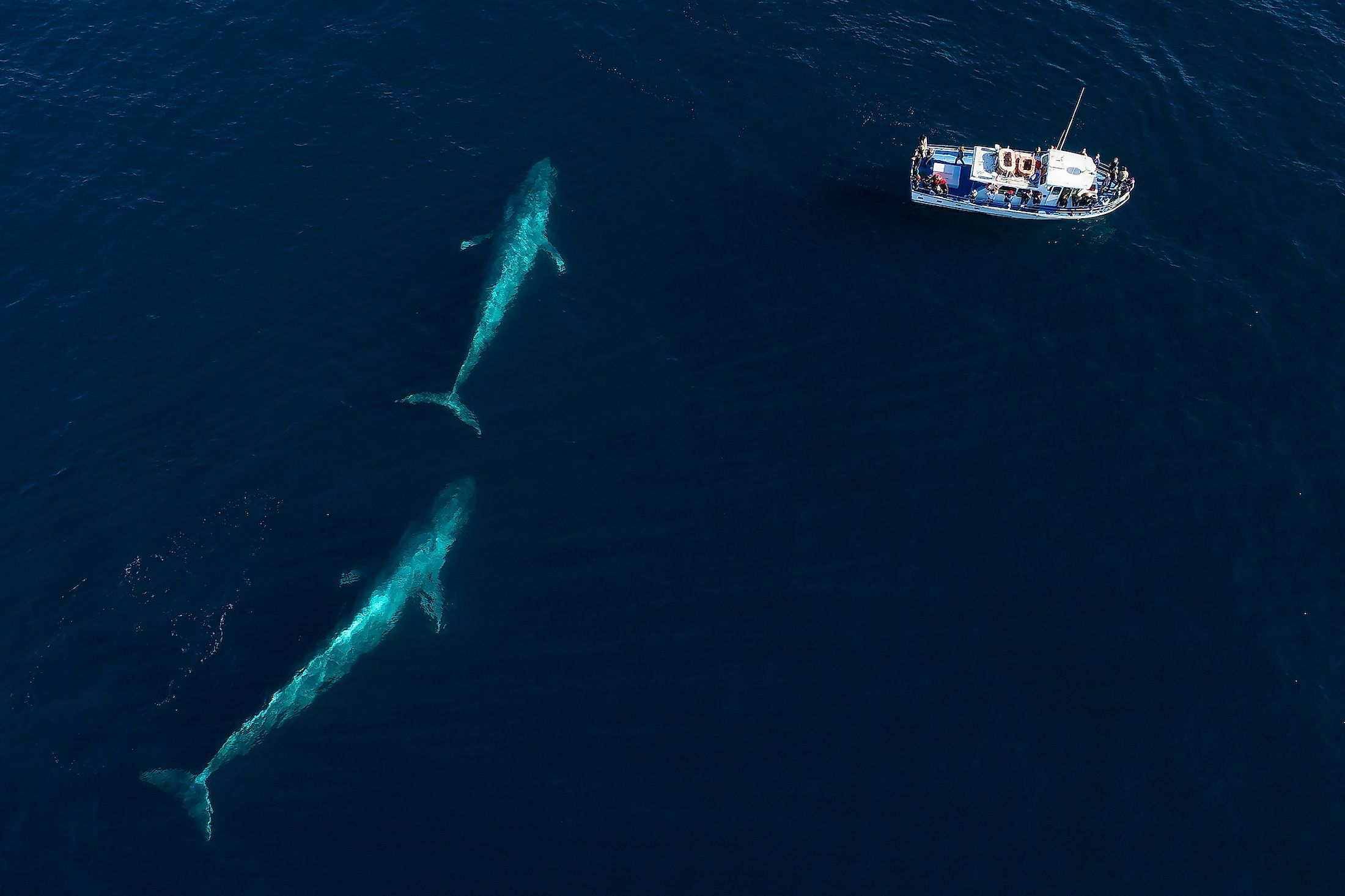
Pacific Ocean
The Pacific Ocean is by far the world’s largest and deepest ocean. It spans over 63 million square miles from China to California, and in some areas, extends thousands of feet below the water surface. The ocean basin covers about 32% of the Earth’s total surface area and 46% of the water surface. To understand how big the Pacific Ocean is, all the world’s landmasses could fit into the ocean, with plenty of space left. The ocean extends from the Arctic region in the north to the Antarctic region in the south. It is sandwiched between South and North America to the east and Australia and Asia to the west.
Contents:
Origin Of The Name
Since prehistoric times, people have traveled across the Pacific Ocean, connecting from one continent or landmass to the other. However, Vasco Nunez de Balboa became the first Europeans to sight the eastern Pacific in 1513 while crossing the Isthmus of Panama and named it "Mar del Sur," meaning the "Southern Sea."
Six years later (1519), Ferdinand Magellan, a Portuguese navigator, began the Pacific Ocean circumnavigation, while seeking an alternative route to Spice Island through South America. In the course of his journey, Magellan encountered rough waters that almost destroyed his vessels. After navigating through a strait (known today as Strait of Magellan), his vessel entered into a calmer patch of unfamiliar ocean in 1520. Magellan called this water body “Mar Pacifico,” meaning “peaceful sea.” Despite the name, the Pacific Ocean is a water body characterized by violent activities, including volcanic eruptions and earthquakes.
Geography
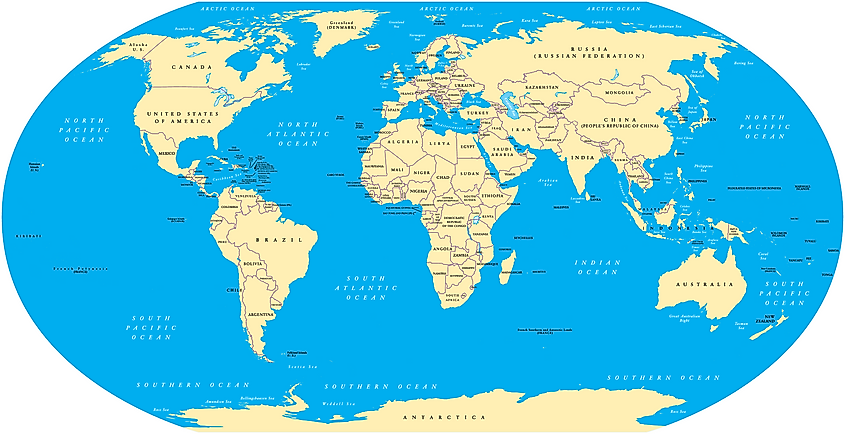
The Pacific Ocean covers approximately 63.8 million square miles, about 5.8 million square miles larger than the Earth’s total landmass. It extends from the Arctic region in the north to the Antarctic region in the south, spanning 32% of the total earth’s surface. The ocean is approximately 12,300 miles wide, from east to west, extending from Indonesia to the Colombian coast. It is 35,797 feet deep at the deepest point, which is at the Mariana Trench. The ocean's average depth is 14,040 feet. Its volume is roughly 170 million cubic miles and contains 27,233 miles of coastline. Due to the plate tectonic movements, the Pacific Ocean’s three sides are currently shrinking by about one inch annually.
The Pacific Ocean hosts some of the world’s largest seas on its margins, including the Philippines Sea, Coral Sea, South China Sea, Tasman Sea, Bering Sea, and the Sea of Okhotsk. These seas are at least 0.5 million square miles. It is joined to the Indian Ocean by the Indonesian Seaway (including Torres Strait and Strait of Malacca), to the Atlantic Ocean by the Strait of Magellan, and the Arctic Ocean by the Bering Strait.
Islands
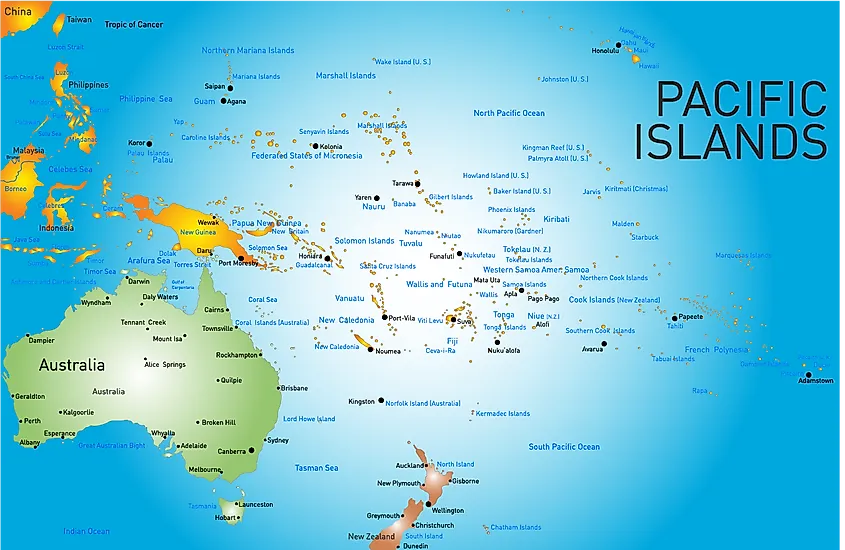
The Pacific Ocean has over 25,000 islands and numerous islets and rocks. The pacific islands are divided into three groups. Micronesia is an island sub-region in the western Pacific made up of four main island groups; the Marshall Islands, Caroline Islands, Mariana Islands, and the Gilbert Islands. Melanesia sub-region in the southwestern Pacific comprises Solomon Islands, Fiji, New Guinea, Vanuatu, and New Caledonia. New Guinea is the world’s second-largest landmass in the ocean after Greenland. Polynesia, the Pacific’s largest sub-region, stretches from New Zealand to Hawaii. It comprises islands such as Austral islands, Tuvalu, Samoa, Tokelau, Tonga, Cooks Islands, Kermadec Islands, Society Islands, Tuamotu, Easter Islands, and Mangareva Islands.
The Pacific islands area is broadly divided into four basic types. The continental islands, coral reefs, high islands, and uplifted coral platforms. Continental islands lie southwest of the Andesite Line and include some of the ocean’s largest islands, such as New Guinea, Vanuatu, New Zealand, and the Marianas. High islands are volcanic in nature, some of which still contain active volcanoes and include Hawaii and Bougainville. Coral reefs are low-lying islands, mainly in the South Pacific Ocean.
Climate
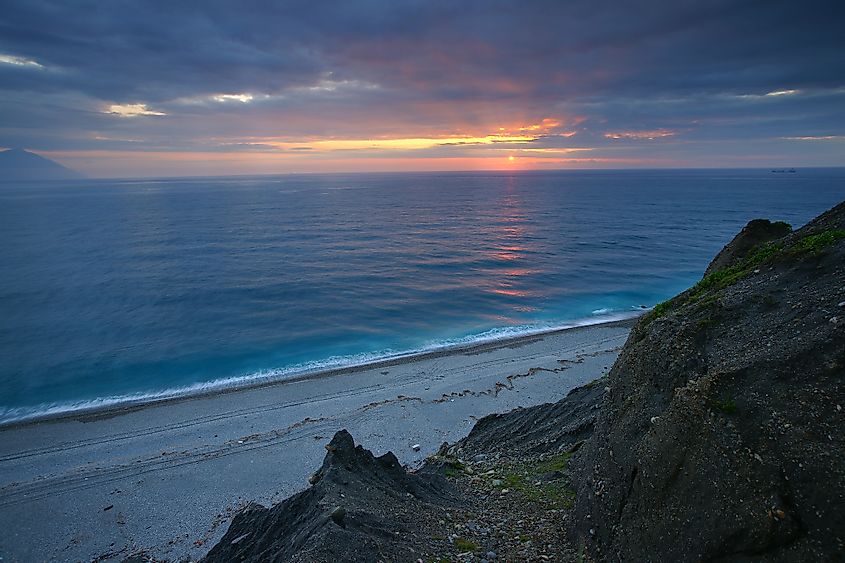
The southern and eastern Pacific has more stable weather patterns compared to North Pacific. The stable weather pattern in the south and east is a result of the steady trade winds. In the North Pacific, some regions, like Russia’s coast, may experience cold winters, while others, like British Columbia, may experience milder weather during the same period. However, most Pacific islands experience a tropical climate (except New Zealand, which experiences a temperate climate), with uniform rainfall, humidity, and temperature.
The weather conditions in the tropical and sub-tropical Pacific are affected by El Nino Southern Oscillation (ENSO). The ENSO’s phase is determined by averaging a 3-month sea surface temperature for about 1,900 miles from Hawaii’s southeast. If the average temperature is 0.9 degrees Fahrenheit below or above normal temperature for a specific period, either La Nina or El Nino is in progress. In the western Pacific, summers are generally wet, while dry winds from the Asian continent blow over the ocean during winter.
Generally, tropical cyclones in the Pacific are common in the summer, when air and water temperature difference is also greatest. The Pacific Ocean hosts two of the world’s seven tropical cyclone basins, namely the eastern Pacific and northwestern Pacific.
Brief History
During the Jurassic Period, the Panthalassa Ocean surrounded the Pangaea supercontinent, whose floor was composed of Phoenix, Farallon, and Izanagi Plates. The Pacific Ocean formed about 750 million years ago when a supercontinent, known as Rodina, broke up. However, the Ocean was known as Panthalassa until about 200 years ago, When Pangea, another supercontinent, broke up.
The Pacific Ocean’s exploration began in the early 16th century, with Francisco Serrao and Antonio de Abreu visiting the western edge in 1512. The following year, Jorge Alvares made an expedition to South China. In 1513, Vasco Nunez de Balboa discovered the ocean’s eastern side and named it “Mar del Sur,” meaning “Southern Sea.” Seven years later (1520) Ferdinand and his crew became the first people to cross the Pacific, naming it “Mar Pacifico.” From the mid-16th century to the end of the 18th century, numerous explorers crossed the Pacific Ocean and established trade routes. Numerous islands were also discovered during this period. In the 19th century, the European powers, Japan, and the US occupied much of the Pacific islands. By the turn of the 20th century, nearly all the Pacific islands were possessed by France, Great Britain, Chile, Germany, the US, and Japan.
Marine Life
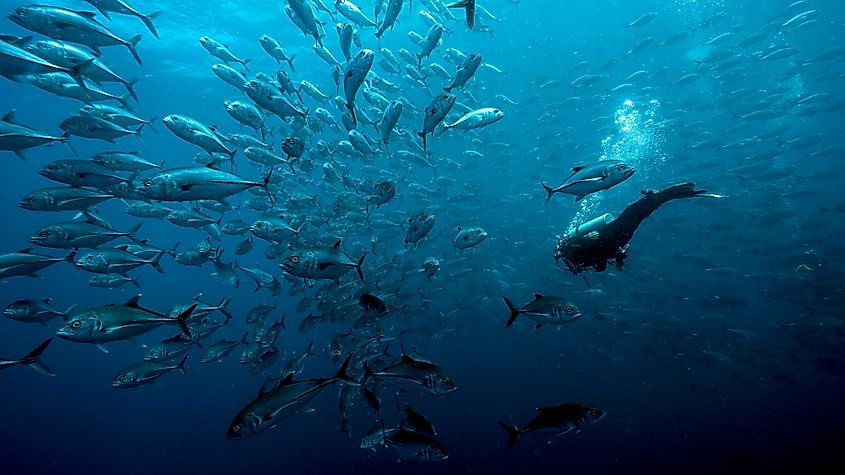
The vastness of the Pacific Ocean serves as home to innumerable species ranging from the primary producers and consumers like phytoplanktons and zooplanktons to apex predators like whales, sharks, killer whales, and others. The coral reefs in the Pacific Ocean act as nurseries of many marine animals. The diversity of life decreases with depth from the surface of the ocean and distance from the equator. The rich marine life of the Pacific Ocean supports many human livelihood activities such as those based on fishing, tourism, etc.
Environmental Concerns
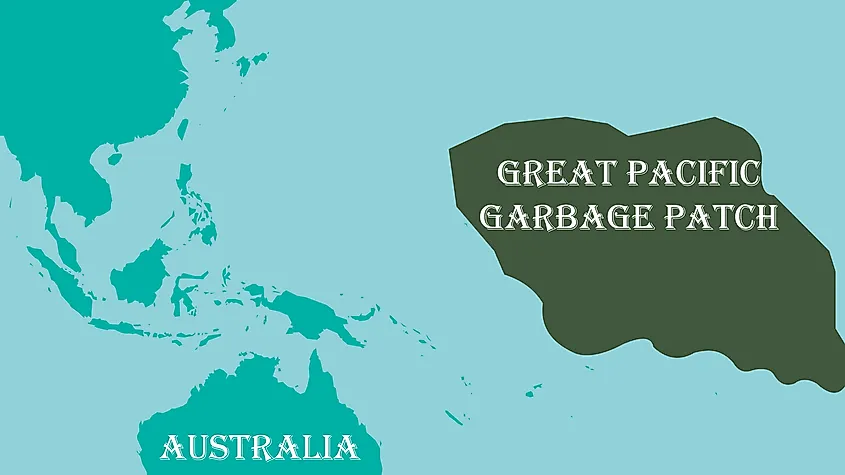
The Pacific Ocean is an important fishing ground and major waterway that connects different continents and countries. Thus, the ocean is prone to pollutions from all sources, including waste disposals, oil spillage, and littering of adjacent beaches. Pollution from small plastic fragments has increased over the years in the last four decades. The Great Pacific garbage patch is rapidly growing, currently covering an area larger than France. The patch comprises over 1.8 trillion pieces of small plastic debris, estimated to be over 80 thousand metric tons.
According to the UN Ocean Conference, there will be more plastics in the world's oceans than fish. Plastic is a major concern to environmentalists and conservationists because of its effects on marine life. Some plastics contain harmful substances that can affect the entire food chain. The debris can also trap and kill animals. About 700 marine species are affected by plastic pollution, including sea lions, turtles, dolphins, whales, fish, and seabirds.











